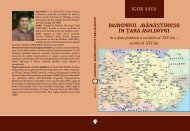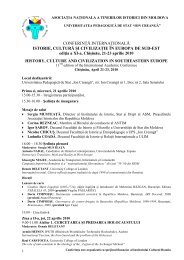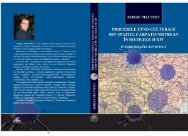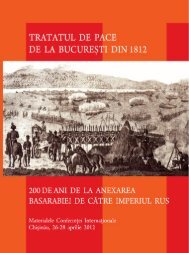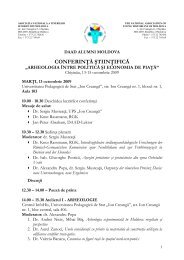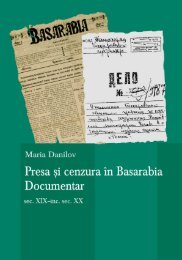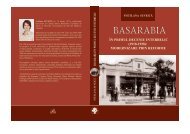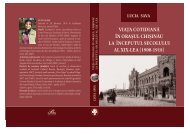Publicatie cu continut integral - Asociatia Tinerilor Istorici din Moldova
Publicatie cu continut integral - Asociatia Tinerilor Istorici din Moldova
Publicatie cu continut integral - Asociatia Tinerilor Istorici din Moldova
Create successful ePaper yourself
Turn your PDF publications into a flip-book with our unique Google optimized e-Paper software.
ıdentıte socıale et comportement sYmBolıQue dans la preHıstoıre de la<br />
roumanıe: art moBılıer au paleolıtHıQue superıeur en transYlvanıe<br />
– –<br />
Corneliu Beldiman , diana-maria SztanCS<br />
abstract<br />
Recent approaches on ancient artifacts collections and relative recent discoveries enable a detailed dis<strong>cu</strong>ssion<br />
(repertory, typology, technology, radiocarbon dates etc.) on the relative rare evidence of earliest portable art<br />
– adornment, decorated objects and so called non utilitarian objects – in the Upper Paleolithic in Transylvania,<br />
Romania (Aurignacian and Eastern Gravettian, about 30 – 13 kya BP). The artifacts were discovered in 5 cave<br />
sites. Most of the pieces (6) are attributed to the Aurignacian and 5 belong to the Eastern Gravettian. The typology<br />
is less diversified, inclu<strong>din</strong>g: a spear point in bone; 3 bâtons percés worked in wolf long bones; 7 red deer,<br />
fox, bear and wolf perforated teeth. The rare Aurignacian artifacts in Romania are five teeth modified by human<br />
intervention discovered in two caves (Cioclovina and Ohaba-Ponor). Of parti<strong>cu</strong>lar interest is the wolf canine in<br />
provenance of last site, perforated by scraping and alternative rotation on both sides of his proximal (apical) part;<br />
it seems to be the oldest perforated object ever known in Romania. The study contributes essentially to the definition<br />
in actual terms of typology and technology of oldest adornment from Transylvania, Romania as material<br />
expression of first spiritual manifestations of hunter-gatherer communities and allowed to integrate the data of the<br />
phenomenon in the European context.<br />
Mots-clef: Aurignacien, bâton percé, dents percées, Gravettien oriental, gravure, industrie des matières dures<br />
animales, os, Paléolithique supérieur, pointe de sagaie, Roumanie, Transylvanie, technologie préhistorique.<br />
Keywords: Aurignacian, bone and antler industry, bone, Eastern Gravettian, perforated teeth, prehistoric technology,<br />
Romania, spear point, transverse sawing, Transylvania, Upper Paleolithic.<br />
introduction: but, méthodes, matériel<br />
Ces derniers ans dans le contexte de la rareté relative des découvertes paléolithiques d’art mobilier et de parure<br />
en Roumanie – en dépit de l’augmentation significatif du répertoire – plusieurs ouvrages ont proposé une approche<br />
extensive sur les diverses catégories d’artefacts de cette sorte (Beldiman, 1993; Beldiman, 1996; Beldiman, 1999a<br />
et 1999b; Beldiman, 2000; Beldiman, 2001a et 2001b; Beldiman, 2003a-f; Beldiman, 2004a-e; Beldiman, 2005a<br />
et 2005b; Beldiman, 2006a et 2006b; Cârciumaru, 1999; Cârciumaru, 2000; Cârciumaru et Dobres<strong>cu</strong>, 1997; Cârciumaru,<br />
Mărgărit, 2002; Cârciumaru, Mărgărit et al., 2003a et 2003b; Cârciumaru, Otte et al., 1996; Cârciumaru,<br />
Mărgărit et al., 2004; Cârciumaru, Anghelinu et al., 2006; Chirica, 1996; Chirica, 2004; Chirica et Borziac, 1995;<br />
Vanhaeren et d’Errico, 2006; Otte, Chirica et Beldiman, 1995).<br />
Après une première aproche (Beldiman, 2001b), à cette occasion nous allons aborder d’une manière extensive<br />
les découvertes d’art mobilier dans les sites du Paléolithique supérieur de la Transylvanie: les objets de parure<br />
(dents percées), les objets utilitaires décorés (pointe de sagaies) et les objets dites non utilitaires ou sans utilisation<br />
bien précisée (bâtons percés). Il s’agit en effet d’un premier essai de synthèse sur les découvertes paléolithiques<br />
du pays (de l’Aurignacien et du Gravettien oriental, environ 30 000 – 13 000 BP).<br />
La démarche a pour but également l’essai d’intégration les aspects actuels de la recherche du domaine (répertoire,<br />
typologie, technologie), en appliquant les modèles inspirés des Fiches typologiques de l’industrie osseuse<br />
préhistorique (Barge-Mahieu, Bellier, Camps-Fabrer et al., 1991) et utilisant les résultats des approches roumaines<br />
récentes. Ainsi on peut essayer de définir les premières manifestations de ce phénomène dans les Carpates et au<br />
Bas Danube et de retracer les grandes lignes de l’évolution paléotechnologique et chrono<strong>cu</strong>lturelle du domaine.<br />
Le lot étudié et/ou dis<strong>cu</strong>tés comporte 11 objets, ce qui représente la totalité de l’effectif connu par nous jusqu’à<br />
maintenant. Actuellement sur les objets d’art paléolithique de Roumanie on dispose encore d’informations de<br />
valeur inégale, ce qui affecte, sans nul doute, la validité des conclusions complètes sur le phénomène étudié (Bel-<br />
1 Université Chrétienne «Dimitrie Cantemir» Fa<strong>cu</strong>lté d’Histoire Splaiul Unirii No. 176 040042 Bucarest Roumanie; www.ucdc.ro;<br />
cbeldiman58@yahoo.com.<br />
2 Université «Lucian Blaga», Fa<strong>cu</strong>lté d’Histoire et pour l’Etude du Patrimoine «Nicolae Lupu», Bd. Victoriei No. 5-7, 550024 Sibiu,<br />
Roumanie; http://arheologie.ulbsibiu.ro.<br />
Analele ANTIM. Revistă de istorie, 8, 2008, p. 6-16



